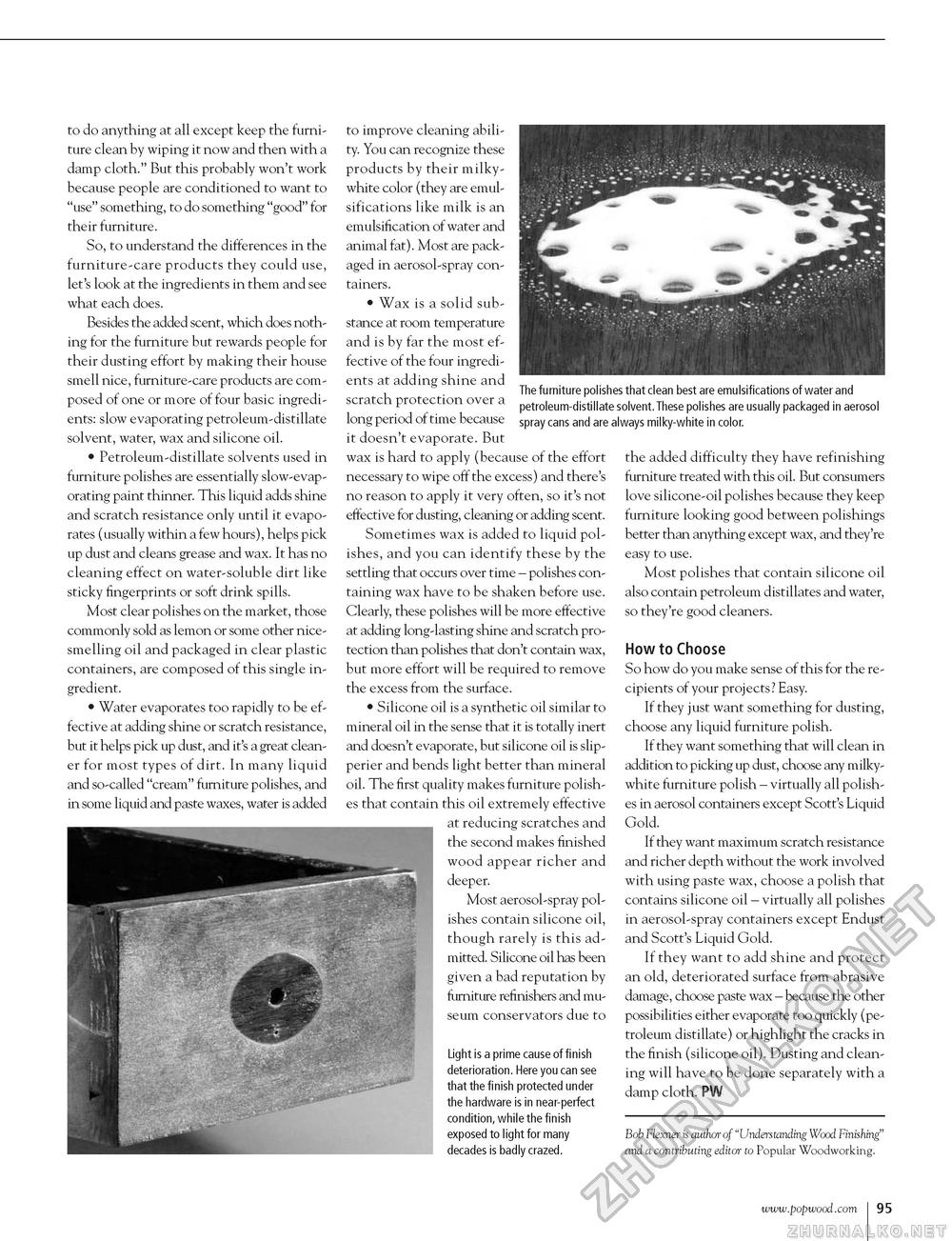Popular Woodworking 2002-02 № 126, страница 96
to do anything at all except keep the furniture clean by wiping it now and then with a damp cloth." But this probably won't work because people are conditioned to want to "use" something, to do something "good" for their furniture. So, to understand the differences in the furniture-care products they could use, let's look at the ingredients in them and see what each does. Besides the added scent, which does nothing for the furniture but rewards people for their dusting effort by making their house smell nice, furniture-care products are composed of one or more of four basic ingredients: slow evaporating petroleum-distillate solvent, water, wax and silicone oil. • Petroleum-distillate solvents used in furniture polishes are essentially slow-evaporating paint thinner. This liquid adds shine and scratch resistance only until it evaporates (usually within a few hours), helps pick up dust and cleans grease and wax. It has no cleaning effect on water-soluble dirt like sticky fingerprints or soft drink spills. Most clear polishes on the market, those commonly sold as lemon or some other nice-smelling oil and packaged in clear plastic containers, are composed of this single ingredient. • Water evaporates too rapidly to be effective at adding shine or scratch resistance, but it helps pick up dust, and it's a great cleaner for most types of dirt. In many liquid and so-called "cream" furniture polishes, and in some liquid and paste waxes, water is added to improve cleaning ability. You can recognize these products by their milky-white color (they are emul-sifications like milk is an emulsification of water and animal fat). Most are packaged in aerosol-spray containers. • Wax is a solid substance at room temperature and is by far the most effective of the four ingredients at adding shine and scratch protection over a long period of time because it doesn't evaporate. But wax is hard to apply (because of the effort necessary to wipe off the excess) and there's no reason to apply it very often, so it's not effective for dusting, cleaning or adding scent. Sometimes wax is added to liquid polishes, and you can identify these by the settling that occurs over time - polishes containing wax have to be shaken before use. Clearly, these polishes will be more effective at adding long-lasting shine and scratch protection than polishes that don't contain wax, but more effort will be required to remove the excess from the surface. • Silicone oil is a synthetic oil similar to mineral oil in the sense that it is totally inert and doesn't evaporate, but silicone oil is slipperier and bends light better than mineral oil. The first quality makes furniture polishes that contain this oil extremely effective at reducing scratches and the second makes finished wood appear richer and deeper. Most aerosol-spray polishes contain silicone oil, though rarely is this admitted. Silicone oil has been given a bad reputation by furniture refinishers and museum conservators due to Light is a prime cause of finish deterioration. Here you can see that the finish protected under the hardware is in near-perfect condition, while the finish exposed to light for many decades is badly crazed. the added difficulty they have refinishing furniture treated with this oil. But consumers love silicone-oil polishes because they keep furniture looking good between polishings better than anything except wax, and they're easy to use. Most polishes that contain silicone oil also contain petroleum distillates and water, so they're good cleaners. How to Choose So how do you make sense of this for the recipients of your projects? Easy. If they just want something for dusting, choose any liquid furniture polish. If they want something that will clean in addition to picking up dust, choose any milky-white furniture polish - virtually all polishes in aerosol containers except Scott's Liquid Gold. If they want maximum scratch resistance and richer depth without the work involved with using paste wax, choose a polish that contains silicone oil - virtually all polishes in aerosol-spray containers except Endust and Scott's Liquid Gold. If they want to add shine and protect an old, deteriorated surface from abrasive damage, choose paste wax - because the other possibilities either evaporate too quickly (petroleum distillate) or highlight the cracks in the finish (silicone oil). Dusting and cleaning will have to be done separately with a damp cloth. PW Bob Flexner is author of"Understanding Wood Finishing' and a contributing editor to Popular Woodworking. www.popwood.com I 95 |








